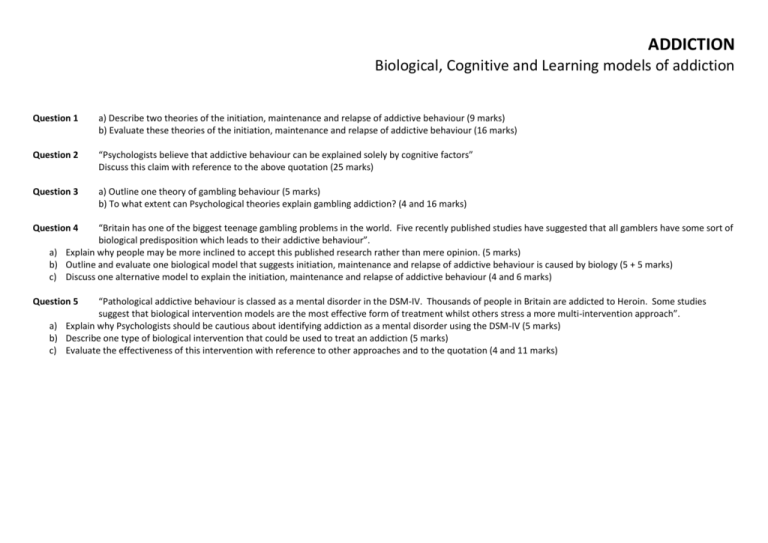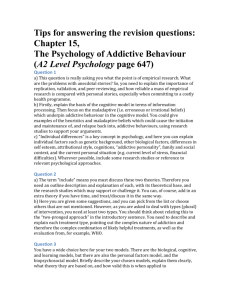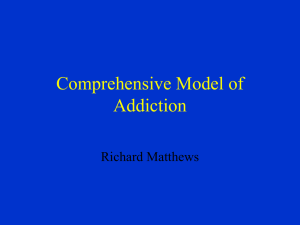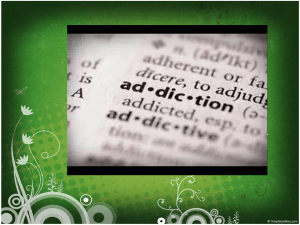For y13
advertisement

ADDICTION Biological, Cognitive and Learning models of addiction Question 1 a) Describe two theories of the initiation, maintenance and relapse of addictive behaviour (9 marks) b) Evaluate these theories of the initiation, maintenance and relapse of addictive behaviour (16 marks) Question 2 “Psychologists believe that addictive behaviour can be explained solely by cognitive factors” Discuss this claim with reference to the above quotation (25 marks) Question 3 a) Outline one theory of gambling behaviour (5 marks) b) To what extent can Psychological theories explain gambling addiction? (4 and 16 marks) Question 4 “Britain has one of the biggest teenage gambling problems in the world. Five recently published studies have suggested that all gamblers have some sort of biological predisposition which leads to their addictive behaviour”. a) Explain why people may be more inclined to accept this published research rather than mere opinion. (5 marks) b) Outline and evaluate one biological model that suggests initiation, maintenance and relapse of addictive behaviour is caused by biology (5 + 5 marks) c) Discuss one alternative model to explain the initiation, maintenance and relapse of addictive behaviour (4 and 6 marks) Question 5 “Pathological addictive behaviour is classed as a mental disorder in the DSM-IV. Thousands of people in Britain are addicted to Heroin. Some studies suggest that biological intervention models are the most effective form of treatment whilst others stress a more multi-intervention approach”. a) Explain why Psychologists should be cautious about identifying addiction as a mental disorder using the DSM-IV (5 marks) b) Describe one type of biological intervention that could be used to treat an addiction (5 marks) c) Evaluate the effectiveness of this intervention with reference to other approaches and to the quotation (4 and 11 marks) BIOLOGICAL MODELS OF ADDICTION GENETICS Initiation: Agrawal & Lynskey COMMENTARY AO2 Diathesis Stress Model Kendler [2003] Inconsistent research findings Noble [1998] Specific Genes and specific drugs Noble [1991] D2 Dopamine receptor gene A1 variant DRD2 linked to range of disorders Comings [1991] Reward Gene THE DISEASE MODEL: Dopamine and Addiction Initiation Reward Circuit COMMENTARY Individual differences. Volkow [2001] Ritalin and numbers of dopamine receptors . More dopamine receptors = don’t like the effect of drugs Maintenance Downregulation Bostwick and Bucci Sex Addiction Relapse Frontal cortex less effective at decision making Ignores social context, role of unconscious, effect of environment Grant’s monkeys Treatment not punishment AO3 LINKS Animal Research: Caine Cocaine mice [2007] Grant’s monkeys Banks treatment of cocaine addiction Not correlational Nature/Nurture Twin Studies McGue Agrawal and Lynskey Kendler Reductionism: Genetic = no control? Chemical = can treat with more chemicals. Volkow and Ritalin=individual vulnerability based on biology But Grant and social factors not just biology COGNITIVE MODELS OF ADDICTION The Self-medication model initiation Gelkopf et al (2002) chosen for a purpose Maintenance and Relapse Smokers and stress Gottdiener meta analysis: [2008] Failure of ego control Cause and effect: Evidence that people do have a problem which they look to solve before becoming addicted Sanjuan [2009] sexually abused women Parrott [1998]: immediate effect vs long term effects Expectancy Model Initiation Expectations about the benefits and costs of the drug Leigh [1987]Can explain individual differences in susceptibility to addiction; some people have stronger beliefs about the negative/positive effects of the drug Maintenance and relapse Expectations become habit Brandon [2004] Expectancy theory does not really explain why some people use more or less of a substance but not why some people lose control and are addicted. Manipulate expectations to influence experience of abstinence. Tate [1994] Rational Choice Theory Initiation Economic model: weigh up costs and benefits Maintenance and Relapse Will act rationally and stop if costs outweigh benefit. BUT don’t always: Cognitive bias results in faulty weighing up Griffiths gamblers. [1994] AO3 LINKS: Publication bias Gender Bias Explains restraint Has implications for treatment. LEARNING MODELS Operant Conditioning Initiation: Positive Reinforcement and the meso-limbic system. Griffiths [2009] Gamblers Maintenance and Relapse: Negative reinforcement Classical Conditioning Initiation: Secondary re-inforcers Commentary Explains conflict between conscious desire to stop and inability to: conditioned response not conscious choice Does not explain why some people who take drugs with positively reinforcing effects do not become addicts: anyone who takes the drug should be conditioned in the same way but they don’t so there must be other factors involved. Returning Vietnam veterans provide support Robins [`1975] Treatment implications: Cue exposure Maintenance and Relapse: threat of withdrawal symptoms Environmental factors that precede drug dose become conditioned stimulus Social Learning Theory Initiation: Observation of positive or negative consequences Lead to different outcome expectations. DiBlasio and Benda [1993] Influence of peer groups Maintenance and Relapse: Approach-Avoidance conflict Presence of multiple cues arouses positive outcome expectations Treatment implications: need to increase self-efficacy Resistance training Botvin [2000] AO3 LINKS Evolutionary perspective: learning from occasional reinforcement Behaviourist approach. SLT and Internet addiction Lin et al [2008] Use of questionnaires Correlations







